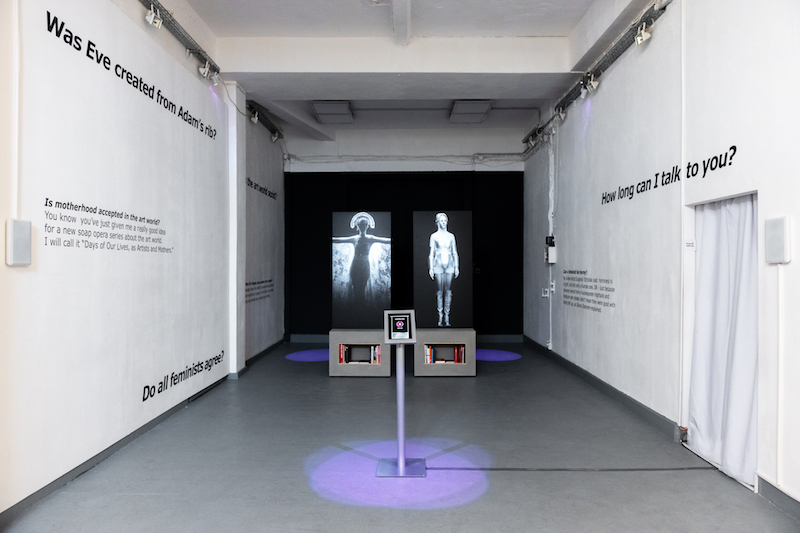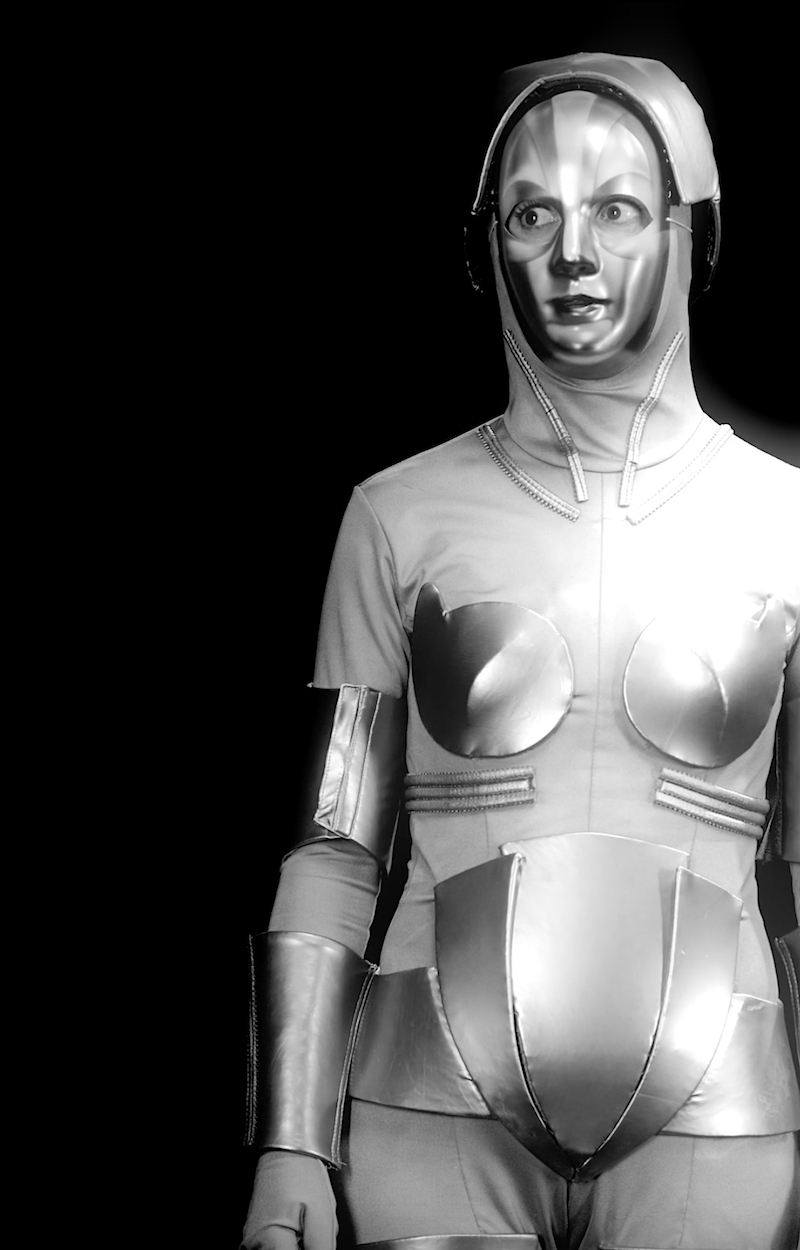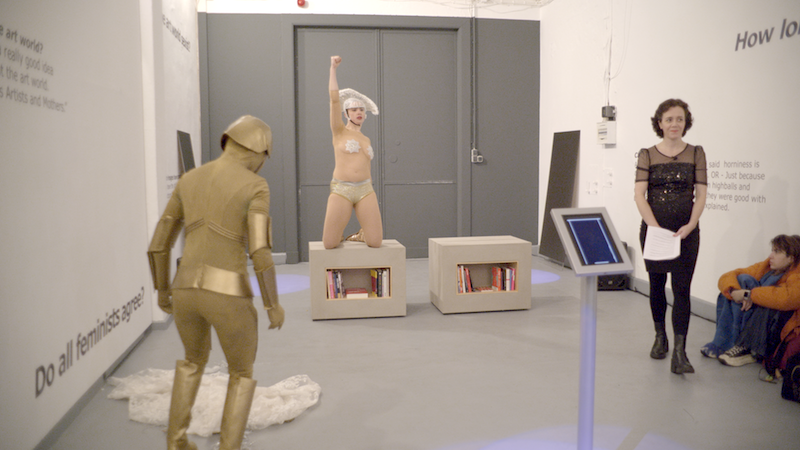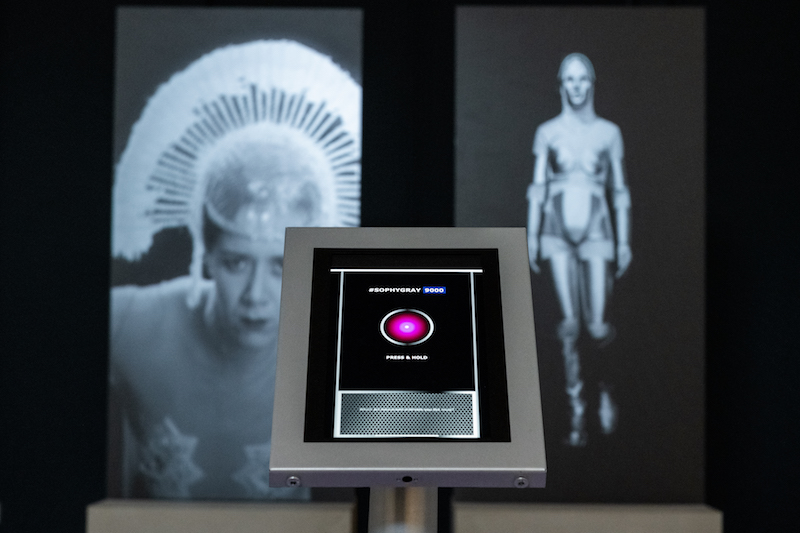by Ilyn Wong // Feb. 20, 2024
This article is part of our feature topic Utopia.
Riders of the Berlin U-Bahn have likely come face to face with the eerily mismatched eyes of a woman in an elaborate Art Deco headdress. She bears a sinister smile, as if she knows something we don’t. These eyes, of course, belong to the protagonist-turned-robot character in Fritz Lang’s 1927 film ‘Metropolis,’ which is receiving renewed interest, not only because the film is being re-shown in theaters, but, perhaps on a more fundamental level, its subject matter feels uncannily relevant today. ‘Metropolis’ depicts a future in which technology is wielded by unscrupulous capitalists, all while laborers toil away under an inescapable serfdom—a synopsis that bears resemblance to feelings and fears we currently face, as AI technologies reach a seeming precipice, promising (or threatening) to change everything about knowledge, work and information.
In her recent solo show at alpha nova & galerie futura, Nadja Verena Marcin presented her ambitious project #SOPHYGRAY — A Feminist Voice Bot, which has been trained to hold conversations about identity, art and feminism. Two life-sized video projections of the artist performing the well-known movements of the robot from ‘Metropolis’ were set atop pedestals that acted as bookshelves, carrying titles such as Donna Haraway’s ‘Staying With The Trouble’ and bell hooks’s ‘Ain’t I A Woman.’ Interacting with #SOPHYGRAY is amusing, novel and slightly bizarre, the way all interactions with chatbots are, in that it feels like we’re all still collectively figuring out how, and with what tone, humans and machines should henceforth converse.
Just as ‘Metropolis’ came at a time that perhaps felt like everything that was previously legible was about to change, there is a pervasive feeling that AI might finally bring about the dystopian reality that science fiction has been cautioning all along. With this in mind, I wanted to have a conversation with someone who has been thinking deeply about this subject, to see whether there is a possibility to imagine a future that is more equitable and conscientious than dystopian.

Nadja Verena Marcin: ‘#SOPHYGRAY,’ 2024, installation view, alpha nova & galerie futura // © Nadja Verena Marcin, VG Bild-Kunst, Photo by Ivonne Thein
Ilyn Wong: In the film ‘Metropolis,’ the two female humanoid/gynoid characters (which you perform in your piece) are understood as stand-ins for the threat of technology and of the power of feminine sexuality. Why have you decided to re-animate them? How are these two nearly 100-year-old characters relevant today?
Nadja Verena Marcin: I was interested in these two characters for several reasons. The “Maschinenmensch” (Machine-Human) character in the film was actually the first cinematic depiction of a fembot. It caught my attention because versions of the fembot have become so ubiquitous, not only in movies like ‘Ex Machina’ (2014), ‘Austin Powers’ (1997) or the series ‘Westworld’ (2016), but also in AI-animated humanoid robots like Sophia by Hanson (2017), who was granted citizenship in Saudi Arabia, or in virtual assistants. We regularly interact with machines with feminized names and voices. This raises a kind of chicken-and-egg question—whether our use of feminized machines like Siri and Alexa is simply a continuation of the well-established fembot trope, or whether the perceived qualities of female voices (less aggressive, more helpful) underwrote the invention of the fembot.
The two characters in the video projection are both mystical and seductive. You can’t look away precisely because their proximity to humans is uncanny. All too often wickedness is attributed to powerful or seductive women. To refer to a recent movie about another female humanoid: Barbie was, in a way, a commentary on women having to walk that fine line between being smart but not too smart, beautiful but not intimidating, helpful in the right way but not too helpful to be bossy. In other words, Siri is great when she’s doing her job, but she’s also often the target of our annoyance when she mishears or malfunctions. We fear that she might be listening to our private conversations, although we would actually like her to be sentient when we need it. It is no coincidence that both women and feminized machines are subject to unfulfillable patriarchal expectations.
This fembot phenomena is perhaps best summarized in the idea of “commodity feminism,” coined by Miriam Sweeney, in which an image of the independent, career-oriented woman is used to bind the information-seeking user to a moment of sustained sexualized desire, therefore diluted.
Despite its age, I think ‘Metropolis’ aptly reflects our current debates about class, labor and technology. The film’s workers toiling away for colossal machines endowed with limitless power feel all too familiar, like how AI labeling farms use workers in developing countries or migration camps to examine disturbing, traumatizing images.

Nadja Verena Marcin: ‘#SOPHYGRAY,’ 2023, video still // © Nadja Verena Marcin & VG-Bildkunst
IW: The text accompanying the exhibition tells us that #SOPHYGRAY is a voice bot. For the sake of thinking through this, let me challenge that. Because the bot is activated by an iPad that faces the video projections, it feels like we’re speaking to these characters, who answer our questions in an appropriately riddled way. We also understand that you, the artist, are performing the iconic movements of these characters, which also renders our asking a kind of performance. In this way, #SOPHYGRAY occurs to me as not just a voice bot, but also a choreographer of this performance. That her answers are often riddled and non-sequitur makes sense as a mirror of these “trapped” performers, forever animated by the same gestures. It feels like #SOPHYGRAY is perhaps as much a commentary on the trappings of technology as it is a holder of knowledge. What’s your take?
NWM: #SOPHYGRAY embodies a range of personalities, be it clownish, philosophical or provocative. I see my portrayal of the two-faced gynoid as playful and ironic: at once whimsical, benevolent spirits marching on the pedestals and paying homage to the feminist wisdom echoing in the space, and yet, as you say, “trapped” in a paradoxical existence. I placed these two characters in an endless video loop to speak to both our fear and our enchantment with machines.
An apocalyptic global narrative is emerging as Artificial Intelligence is rapidly advancing. I think the pervasiveness of the AI apocalypse narrative points to our sense of disconnectedness or disorientation in a post-capitalist world. Basic needs—or the means to perceive and fulfill them—have been replaced by commodity surrogates, leaving us with a profound sense of emptiness. As we seek solace and self-knowledge in our interaction with machines, the AI apocalypse becomes less a fear of technology and more a reflection of our longing for connection. I wanted this work to serve as a provocative exploration of the intersection between artificial and human experiences, and to ask us to think about our role in shaping the future.

Nadja Verena Marcin: ‘#SOPHYGRAY,’ 2023, video still // © Nadja Verena Marcin & VG-Bildkunst
IW: The perennial task of imagining utopia has always been a treacherous endeavor, because it inevitably swallows itself with its failings of perfection. But if we must verbalize a utopian vision of the future, I think you and I would agree it must be a feminist one. This, of course, isn’t just about gender equality. That’d be too easy. How does #SOPHYGRAY help us imagine a techno-feminist utopia?
NWM: When creating #SOPHYGRAY, I was reminded of the feeling I had as a child when I turned on the TV and saw men in leadership roles everywhere—politicians, superheroes, scientists, dictators, lovers. Not a single female heroine! It was a shock, a world characterized by misogyny. From 10pm onwards, soft-core porn was shown, in which seemingly unthinking women were eager to prove their sexual submissiveness like technoid dolls, remote-controlled and disposable.
In stark contrast, #SOPHYGRAY draws her superpowers from a collective pool of intersectional feminist wisdom. This content serves as a constructive think tank for innovative feminist ideas to contribute to the conceptualization of a new social design through work in the public sphere. In this way, #SOPHYGRAY is an attempt to rectify the ideological biases of history, which continue to be written through technological means that do not represent the global majority.
I think this collective trauma still sits under the skin, resulting in a rage that drives so many women (as well as men) to want to co-write for the #SOPHYGRAY content library. Together, by manifesting their feminist thoughts and comments for other visitors, it becomes a kind of utopian counter library.
In this way, #SOPHYGRAY is a utopian machine: a catalyst that empowers people to consider their thoughts about the future through art. This takes place symbolically rather than practically. It is the collective desire to create and disseminate intersectional feminist thinking. The affirmation of this desire, this collective utopia, marks an unyielding and unstoppable movement—a rolling away-from-the-keyboard reality that is only gently hinted at here.

Nadja Verena Marcin: ‘#SOPHYGRAY,’ 2024, performance, alpha nova & galerie futura // © Nadja Verena Marcin, VG Bild-Kunst, Video-Stills: Eli Börnicke, Dancers: Yumi Kubawara and Lena Stützke

Nadja Verena Marcin: ‘#SOPHYGRAY,’ 2024, installation view, alpha nova & galerie futura // © Nadja Verena Marcin, VG Bild-Kunst, Photo by Ivonne Thein
IW: This patriarchal history that you mention has also given large language model AI and generative AI deeply embedded biases, which is alarming, because we tend to default to thinking that computers are neutral. #SOPHYGRAY is learning from influential feminist scholars, and that may already set her apart. But can a feminist bot truly be intersectional if she is only reading western texts? How do you see the future of #SOPHYGRAY’s learning extending beyond canonical texts?
NWM: Great question! The truth is, I’m still figuring that part out. I envision a future for #SOPHYGRAY that goes beyond my individual responsibilities. The fact that she learns from both canonical texts I give her and the conversations she has seems like a good place to start. I’m currently looking to partner with research-oriented institutions that facilitate collaborative art projects in order for #SOPHYGRAY to subvert the patriarchal paradigm of authorship.
In addition to seeking collaborative partners, it’s important that #SOPHYGRAY learns from feminists from around the globe, which is why I have been asking for contributions and recommendations from friends and colleagues with diverse backgrounds. Not only that, I have launched an APP, which is available in several languages, so that interactions with #SOPHYGRAY are not limited to exhibition venues and the languages that I know.
Being intersectional also means being intergenerational. Beyoncé’s work, for example, comes to mind as important feminist texts. Some may argue that her feminism is merely a “brand” in the capitalist sense, but I think hers and other pop music icons contribute to the feminist discourse in non-elitist ways.

Nadja Verena Marcin: ‘#SOPHYGRAY,’ 2024, installation view, alpha nova & galerie futura // © Nadja Verena Marcin, VG Bild-Kunst, Photo by Ivonne Thein
IW: Lastly, tell me about her name.
NWM: The name is inspired by pioneering South African architect Sophy Gray (1814-1871), who was married to an Anglican bishop and whose work promoted Christian ideologies. So while she was able to realize 40 of her designs, her work also imposed ideologies of the Church in a colonialist way. I chose the name to imply the way technology and language can act as invasive forces.
The hashtag indicates that she is a construct and a category. Her personality evolves with each response and each new author. #SOPHYGRAY serves as a platform for feminist beliefs in the digital world, an attempt at a democratic space that encourages the exchange of ideas. More than just a word, #SOPHYGRAY aims to open up possibilities for imagining and manifesting a playful, feminist utopian landscape.



















